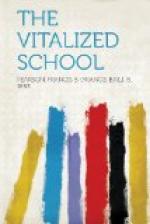=The child’s native tendencies.=—Then, again, the child has a right to the exercise of the native tendencies with which he is endowed. In fact, these tendencies should be the working capital of the teacher, the starting points in her teaching. There was a time when the teacher punished the child who was caught drawing pictures on his slate. Happily that sort of barbarity disappeared, in the main, along with the slate. The vitalized teacher rejoices in the pictures that the child draws and turns this tendency to good account. Through this inclination to draw she finds the real child and so, as the psychologists direct, she begins where the child is and sets about attaching to this native tendency the work in nature study, geography, or history. When she discovers a constructive tendency in the child, she at once uses this in shifting from analytic to synthetic exercises in the school order. If he enjoys making things, he will be glad of an opportunity to make devices, or problems, or maps.
=The play instinct.=—She makes large use, also, of the play instinct that is one of his native tendencies. This instinct is constantly reaching out for objects of play. The teacher is quick to note the child’s quest for objects and deftly substitutes some phase of school work for marbles, balls, or dolls, and his playing proceeds apace without abatement of zest. The vitalized teacher knows how to attach the arithmetic to this play instinct and make it a fascinating game. During the games of arithmetic, geography, history, or spelling, life is at high tide in her school and the work is thorough in consequence. Work is relieved of the onus of drudgery whenever it appears in the guise of a game, and the teacher who has skill in attaching school studies to the play instinct of the child will make her school effective as well as a delight to herself and her pupils. In such a plan there is neither place nor occasion for coercion.
=Self-expression.=—Another right of the child is the right to express himself. The desire for self-expression is fundamental in the human mind, as the study of archaeology abundantly proves. Since this is true, every school should be a school of expression if the nature of the child is to have full recognition. Without expression there is no impression, and without impression there is no education that has real value. The more and better expression in the school, therefore, the more and better the education in that school. In the vitalized school we shall find freedom of expression, and the absence of unreasoning repression. The child expresses himself by means of his hands, his feet, his face, his entire body, and his organs of speech, and his expression through either of these means gives the teacher a knowledge of what to do. These expressions may not be what the teacher would wish, but the expression necessarily precedes intelligent teaching.




